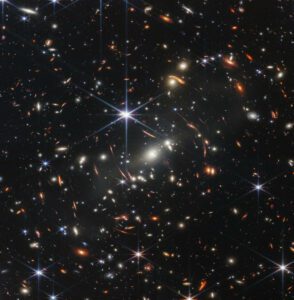
Budapest, 12 July 2022. – NASA has published the James Webb Space Telescope’s deepest and sharpest infrared image of the distant Universe so far, known as Webb’s First Deep Field, an image of galaxy cluster SMACS 0723.
The image contains thousands of galaxies, including the faintest objects ever observed in the infrared part of the spectrum. It was taken by focusing on a small part of the sky, about the same size as a grain of sand held at arm’s length.
The telescope’s Near-Infrared Camera (NIRCam) produced this composite from images taken at different wavelengths during a total of 12.5 hours. A similar picture taken by the Hubble Space Telescope took weeks to produce and it never reached the depths and clarity of the JWST image.
The image shows galaxy cluster SMACS 0723 as it appeared 4.6 billion years ago. The mass of the cluster acts as a gravitational lens, magnifying the galaxies behind it, which were then brought into focus by NIRCam. The new image shed light on tiny, faint structures that have never been seen before, including star clusters and diffuse features, according to NASA. JWST will help researchers learn more about the masses, ages, histories, and compositions of galaxies.
The full suite of the telescope’s first-full color images will be released later today.
 SpaceWatch.Global An independent perspective on space
SpaceWatch.Global An independent perspective on space




